Gaming God

It's impossible to deny the epic scale of religious histories. That may help to explain why so many video games take such inspiration in their theologies (here's looking at you multiple Jesus-clone messiah protagonists). In essence, they're a ready-made source of rich and detailed adventures with profound resonance, their enduring popularity and name-recognition long-since assured. What publisher wouldn't want that?
Of course, the other side of the equation looks a little less rosy. The odds of offending large swathes of your potential player base only increase when tapping into existing religions, meaning most developers using them play around with their presentation to a greater or lesser degree. The following seven games all opted to take that risk, representing complex belief systems via the interactive medium. Some edged closer to the sacred scripture than others, but all shall be judged of their worthiness. Do any of these games offer a worthwhile introduction to the great gamut of the gods? Let's find out.
Too Human (Norse)
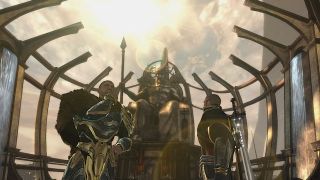
Developer Silicon Knights envisaged Too Human as an attempt to rationalise complex Norse theology via futuristic technology. Here the gods of the pantheon are not born, but made, granted their astounding powers through advanced cybernetic augmentation. In place of the nine realms of existence, Too Human supposes a singular planet, broken up into numerous distinct sectors, such as the human city of Midgard. Their implacable opposition - the giant folk of Jtnar, are now sentient machines, while the likes of Beowulf's Grendel and the menacing Dark Elves become simple boss and enemy types.
As for the game's hero, Baldur - god of light, joy, purity and presumably also lollypops - Too Human opts to introduce us to a much gruffer deity. Expanding upon the most famous of all Baldur stories - his untimely death (as orchestrated by the mischievous half-god Loki), Too Human takes both this and other existing legends as the basis for an entirely new saga, one based upon rebirth and ultimately revenge. As an introduction to Norse theology, Too Human represents a strong and surprisingly accurate start, familiarising players with the names, relationships and dwelling places of these Germanic-Scandinavian gods. If you can ignore the sci-fi trimmings, shoddy gameplay and freshly expanded lore, then Too Human is a good a way as any to begin your ongoing course in Norse.
See Also - Age of Mythology, Jotun (2016), Viking: Battle for Asgard
God of War (Ancient Greek)
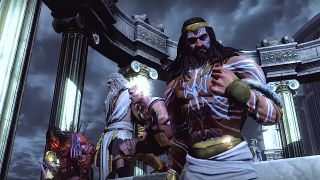
Strange as it may sound, the single most inaccurate element of the entire God of War franchise is the game's ongoing depiction of central character Kratos. Indeed, far from being the frenzied father-stabber that he appears in the games, the theological Kratos is instead counted among the most zealously loyal of Zeus' retinue. He's also considered the God of Strength, as opposed to the demi-god and later God of War he's portrayed as in the games. That being the case, it seems highly likely that Sony Santa Monica chose the name Kratos as an ironic nod to the original character, inverting not only his loyalties but also on occasion his actions. Case in point, the scene in which a virtual Kratos frees the heroic titan Prometheus, having done just the opposite according to the original Greek narrative.
Like many of the games on this list, the God of War franchise positively excels in taking existing theological legends and using them to create new and exciting adventures. One such example is the renewed Titan vs. God war, the big round two of an event that dominates much of the ancient theology. While Kratos' actions may not bear much relation to the stories upon which his world is based, God of War remains a fine foreword to the rest of ancient Greek mythology. After all, what better way to become accustomed to the characters, places and epic tales than by cutting a bloody swathe right through them?
See Also - Age of Mythology, Disney's Hercules, NyxQuest: Kindred Spirits, Spartan: Total Warrior, Titan Quest
Okami (Shinto)
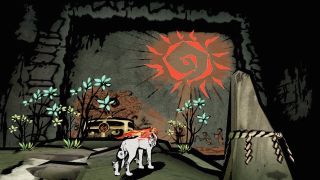
Despite some rather obvious parallels Okami's exact relationship to the Shinto theology remains somewhat difficult to define. That's because the team at Clover Studios has always tended towards a vague and imprecise language when discussing that facet of the project. Game director Hideki Kamiya argues that Okami's characters, in particular Amaterasu, are not necessarily the same as those found in the Shinto faith, though they do share a great deal in common. It's possible that this tack was taken simply to avoid offending believers, though it could also indicate an intentional level of ambiguity.
Familiarities (and differences) include the aforementioned Amaterasu, goddess of the sun in both Shinto tradition and in Okami. Interestingly however, no mention of wolves or wolf-form is ever made in reference to the Shinto deity, while the virtual version is neither strictly male nor female, at least not in the Japanese version of the game (translation difficulties forced the team to pick an English pronoun i.e. he or she, thereby confusing the issue). As for the game's celestial brush gods, none appear to correspond directly with Shinto deities, but are instead based upon the Far Eastern Zodiac signs. Susano meanwhile appears somewhat similar to the Shinto hero Susano-o - both of whom are famous for slaying (or helping to slay) an 8-headed serpent named Orochi. As a guide to Shinto deities, Okami is hardly authoritative, not would the game's designers have you believe that it is. All told, those wishing to learn more about Shinto via the game should probably support their playthrough with the odd spot of research.
See Also - Okamiden
Asura's Wrath (Hinduism/ Buddhism)

Basing a game on the tenets of an active religion is always going to prove tricky. Basing a game on two even more so. Asura's Wrath manages to monkey around with details of both the Hindu and Buddhist faiths (the two groups share a number of common legends, including those drawn from the Indian epic The Rigveda). That's not to say that either side became too irate about it, most just balking at the perceived inaccuracies. So what exactly did the game get right, and more importantly, what did it get wrong? Well for starters, the game - much like Too Human - opts to take the sci-fi reinvention route, trading in powerful demi-gods for massively upgraded cyber soldiers.
Speaking of demi-gods, the term Asura actually applies to all beings of this type, not just to any one individual. The game also leaves out the more benevolent set of deities known as the Devas, although the game's final boss Chakravartin may be considered as such. While religious tradition holds that the two sets of gods waged war upon each other, Asura's Wrath finds these so-called 'Guardian Generals' (i.e. the Asura) battling it out against the Gohma, a race of hideous monsters led by Vlitra, a planet-devouring serpent similar to Vritra, an evil demigod from Hindu Vedic tradition. The Gohma, meanwhile, appear to have little to no basis in religious texts. All things considered the game does present a solid introduction to the Asura deities, not individually perhaps but rather as a group, nailing their look, temperament and abilities as recounted in various religious texts. The rest, however remains somewhat less authentic.
Sphinx & the Cursed Mummy (Ancient Egyptian)

You might expect that there'd be a litany of titles covering the ancient Egyptian pantheon, and you'd be right, though precious few of those exist outside of the god game and RTS genres. Consider Sphinx and the Cursed Mummy a rare exception to that rule, dealing as it does with the likes of Ra, Set, Osiris and co. through the format of an action-platformer. The game stars Sphinx, an upright, decidedly more human take on the beastly man-lion hybrids that guard many an Egyptian temple. Truth be told, this incarnation is little more than a teenager with a tail, though other ancient icons ring truer. Horus has his falcon head, Anubis is a jackal and Tutankhamen is covered from head to tow in bandages. Likewise, King Tut's mummification also results in the storage of four sacred organs, just as it would have in ancient days.
Interestingly however, the game also chooses to shift around several well-established relationships. Tutankhamen's mother and father become his lover and brother, respectively, head honcho Ra is created via the union of Osiris and Set - as opposed to being his own independent deity - and Osiris' son Horus is now working for Set, instead of actively trying to murder him. These elements aside, Sphinx and the Cursed Mummy does an entertaining job of familiarising fans with the unique iconography - think ankhs, amulets and sarcophagi - as well as many of the major players of the ancient Egyptian tradition.
See Also - Age of Mythology, Pharaoh, Ankh: Battle of the Gods
Dante's Inferno (Christian)
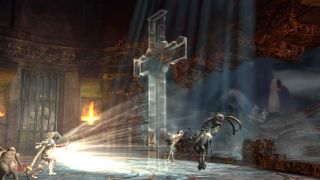
Alright, first things first - Dante Alighieri's Inferno isn't exactly considered canon by the Christian church. However the epic poem does make use of, and even helped to inform, certain elements of popular Christian theology. Suffice to say, this blood and guts actioner shouldn't be taken as a literal guide to Christian tradition, but rather as the retelling of an influential Christian myth. So, how does it fare? Well, much like the gameplay itself, largely hit and miss. Alighieri's epic poem stars none other than the author himself, indulging in a brisk walking tour of the nine levels of Hell. Digital Dante, meanwhile finds himself recast as a fighting knight of the third Crusade, wading through the underworld so as to free his beleaguered lover from Satan's icy grip.
The game does get a lot right, including the presence of Roman poet Virgil, who acts as guide to both iterations of Dante. Likewise, many of the levels of Hell, and the punishments performed therein, reflect those originally envisaged by the writer. Other translations prove less authentic, with the knife-wielding babies of the purgatory level proving particularly false. So too the use of Cleopatra as a willing servant of Satan, as opposed to the simple prisoner she appears in the poem. Strangest of all however, is the inclusion of an absolve/punish mechanic for beaten enemies. Somehow it seems difficult to believe that the Church would sign off on an admitted sinner forgiving other offenders their sins. All in all then, a decent visual trip through quasi-Christian tradition, chock full of crosses, demons and holy iconography. Just take it with a massive pinch of salt.
See Also - Super Noah's Ark 3D?
Folklore (Celtic)
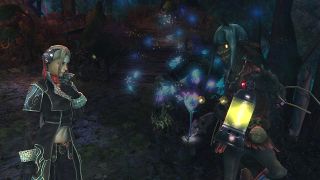
A surprisingly popular tradition, at least where video game settings are concerned, the world of Celtic theology entirely informs the 2007 RPG Folklore. The title takes place in a small country village that just so happens to act as a functioning gateway to a bizarre realm of the dead. In keeping with Celtic tradition, this fissure only appears once every year - on the night of Samhain, to be precise, a major inspiration for modern Hallowe'en - leading the spirits of the dead to revisit our world, as adventurous peoples head off in the other direction. Folklore's depiction of this netherworld is largely in keeping with that of the ancient Celts, drawn an underground paradise - known alternatively as Mag Mell or Tr na ng - made up of strange and fantastical creatures.
These inhabitants, or 'folk' will occasionally attempt to kill the player (somewhat less authentic, though as the game explains, other adventurers have previously 'broken' the paradise) and are largely modelled after fabled Celtic creatures. Taken as a whole, the game provides a strong overview of ancient Celtic theology, though crucially it does gloss over the role of the actual gods, including Balor, Crom and Morrigan. As such, it might better be described as a game of mythology, or as the title itself states, folklore.
See Also - Bloodforge (much greater focus on the Gods - terrible, terrible game), Hellblade (2016), Sorcery

